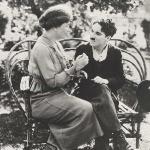In the early hours of the morning on January 5, 1895, Mrs. Baptiste, “a colored woman,” found “a small black coffin” in front of her residence in New Orleans at Royal Street and Caffin. Once Baptiste realized what was on her stoop, a large crowd of residents congregated at her house and “considerable excitement prevailed.” Sergeant Hevron of the Fifth Precinct arrived and “took charge of the box.” With a hatchet he pried off the coffin’s lid and inside revealed “several candles, a wire mask, and a shirt made out of a oat sack” arranged in such a way as “to represent a body.” For her part, Baptiste was “badly frightened” of the coffin since she “terms herself a voudou.” Her own house had been raided by the police before and “a lot of snakes in bottles, bones, and bundles of letters from her victims” had been uncovered. While it was unknown who placed the coffin at her door, it was clear that they meant her harm. (Story and quotes from “A Voudou Victim. A Coffin on the Doorstep Creates a Sensation,” 6 January 1895, The Daily Picayune; image from George Washington Cable, “Creole Slaves Songs,” The Century Magazine, April 1886).
Stories like this, of people seeking supernatural powers to work their will, proliferate throughout American history. As Owen Davies’s recent book America Bewitched: The Story of Witchcraft After Salem (OUP, 2013) demonstrates, America’s relationship with witchcraft did not conclude with Salem in 1692.America Bewitched is an enjoyable read, and one that served as a nice break from working on my dissertation. The book is geared towards a popular audience and so it reads at a pleasant pace with little theory. The chapters are full of story after story of witches and witchcraft in American history from the seventeenth century through the twentieth. The bulk of the prose is narrative surrounding these stories, which range from entertaining or funny, but are more often tragic and gruesome.
As a book written for a wide audience, the book is not argument driven, but this does not mean that it makes no contributions. One of the book’s main strengths is Davies’s attention to the interactions and overlap between the witchcraft beliefs, practices, and fears of early Euro-Americans, recent immigrants, Africans and African Americans, and Native Americans. The porous nature of ideas regarding witchcraft illuminates the realities of what happens when various groups live close together in towns, on plantations, and in tenements. The result is a fascinating tale with a myriad of actors. Additionally, Davies covers witchcraft in all different places and spaces—Alaska; the West; New Orleans; western Pennsylvania; Santa Fe; Norfolk County, Virginia; Galveston, Texas; San Francisco; Memphis; and the Five Points of New York City. Davies finds accusations, folklore, and court cases involving witchcraft from all across the country, dispelling any notion that “superstitious” people are found in any one kind of place or one kind of community.
Read the rest here
















